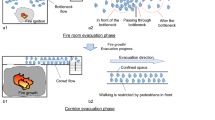Abstract
The hydraulic model is a set of closed-form, deterministic equations used to predict average crowd speeds and movement times of evacuees exiting a building. The standard SFPE hydraulic model assumes that crowd speed is only influenced by crowd congestion and type of terrain, when in fact, it is also affected heavily influenced by smoke, which not only causes evacuees to slow down due to poorer visibility but may also force them to switch a different movement mode: crawling. This paper gathers and refines empirical data from various published experiments involving individuals and groups moving through smoke by walking upright and crawling, to establish two new variants of the hydraulic model describing the movement of crowds through smoke by the two movement modes.








Similar content being viewed by others
Notes
The walking height was calculated at 1.78 m, which is the eye height of the 95th percentile adult male based on anthropometric US data [18]
Similarly, the crawling height was determined to be 0.76 m [18]
The walking height was calculated at 1.78 m, which is the eye height of the 95th percentile adult male based on anthropometric US data [18]
Similarly, the crawling height was determined to be 0.76 m [18]
Abbreviations
- BHM:
-
Basic Hydraulic Model
- SMHM:
-
Smoke-Modified Hydraulic Model
- CMHM:
-
Crawl-Modified Hydraulic Model
- \(S\) :
-
Average crowd velocity, [m/s]
- \(D\) :
-
Average crowd density, [persons/m2]
- \({F}_{C}\) :
-
The flow rate of a pedestrian stream, [persons/s]
- \({W}_{p}\) :
-
Physical width of a passageway, [m]
- \(BL\) :
-
One-sided boundary layer width of a passageway, [m]
- \({W}_{e}\) :
-
Effective width of a passageway, [m]
- \({F}_{s}\) :
-
Specific flowrate, i.e., flowrate per unit of effective width [persons/(m s)]
- \({F}_{sm}\) :
-
The maximum specific flowrate of a crowd, [persons/s/m effective width]
- \(k\) :
-
Structural speed modifier for speed calculation, to account for the type of passageway, e.g., ramp, corridor, stairway, etc. [dimensionless]
- \({C}_{s}\) :
-
The extinction coefficient [m−1 or dB/m], a measure of smoke density
- VA :
-
Visual acuity [dimensionless]
- \({R}_{{v}_{smoke}}\) :
-
Mobility: a speed reduction factor that accounts for lower visibility in smoke, [dimensionless]
- \(IWS\) :
-
Average Walking speed of an individual unimpeded by congestion or smoke [m/s]
- \(I{WS}_{i}\) :
-
Initial Walking speed of an individual unimpeded by congestion or smoke [m/s]
- \(I{WS}_{max}\) :
-
Maximum Walking speed of an individual, unimpeded by congestion or smoke [m/s]
- \({D}_{u}\) :
-
Maximum safe crowd density above which there is a risk of a crowd crush, [persons per m2]
- \({D}_{l}\) :
-
Maximum crowd density, [persons per m2], below which the crowd would have the same speed as an unimpeded individual, \(IWS\)
- \({S}_{c}\) :
-
Projected crawling speed of a crowd [m/s]
- \({S}_{s}\) :
-
Projected speed of a crowd in smoke, while walking upright (m/s)
- \({k}_{c}\) :
-
Structural speed modifier for crawling though a 90° turn
- \({n}_{90(uv)}\) :
-
Number of 90° turns along the path of a crawling crowd from the source till arc \((u,v)\)
- DLP :
-
Distance between the transmitter and the receiver in a visual smoke density measurement device, [m]
- \(I\) :
-
Luminous intensity of the transmitted light after it has passed through a smoke layer, [cd]
- \({I}_{o}\) :
-
Luminous intensity of the incident light, [cd]
References
Fire and Smoke - Emergency Preparedness - Loyola University Maryland. https://www.loyola.edu/department/emergency-preparedness/hazard-information/fire-smoke. Accessed 1 Jun 2020
Gwynne SMV, Rosenbaum ER (2016) Employing the hydraulic model in assessing emergency movement. In: Hurley MJ, Gottuk D, Hall JR et al (eds) SFPE handbook of fire protection engineering. Springer, New York, pp 2115–2151
Schadschneider A, Klüpfel H, Kretz T, et al (2009) Fundamentals of pedestrian and evacuation dynamics. In: Multi-agent systems for traffic and transportation engineering, pp 124–154
Older SJ (1968) Movement of pedestrians on footways in shopping streets. Traffic Eng Control 10:160–163
Jin T (1997) Studies on human behavior and tenability in fire smoke. Fire Saf Sci 5:3–21
Frantzich H, Nilsson D (2004) Evacuation experiments in a smoke filled tunnel. Interscience Communications, pp 229–238
Ronchi E, Gwynne SMV, Purser DA, Colonna P (2013) Representation of the impact of smoke on agent walking speeds in evacuation models. Fire Technol 49:411–431. https://doi.org/10.1007/s10694-012-0280-y
Yamada T, Akizuki Y (2016) Visibility and human behavior in fire smoke. In: Hurley MJ, Gottuk D, Hall JR et al (eds) SFPE handbook of fire protection engineering. Springer, New York, pp 2181–2206
Seike M, Kawabata N, Hasegawa M (2016) Experiments of evacuation speed in smoke-filled tunnel. Tunn Undergr Space Technol 53:61–67. https://doi.org/10.1016/j.tust.2016.01.003
Gwynne SMV, Boyce KE (2016) Engineering data. In: Hurley MJ, Gottuk D, Hall JR et al (eds) SFPE handbook of fire protection engineering. Springer, New York, pp 2429–2551
Xie H (2011) Investigation into the interaction of people with signage systems and its implementation within evacuation models. PhD dissertation, University of Greenwich
Muhdi R, Davis J, Blackburn TJ (2006) Improving occupant characteristics in performance-based evacuation modeling, pp 1199–1203
Kady RA, Davis J (2009) The impact of exit route designs on evacuation time for crawling occupants. J Fire Sci 27:481–493. https://doi.org/10.1177/0734904109105320
Kady RA (2012) The development of a movement–density relationship for people going on four in evacuation. Saf Sci 50:253–258. https://doi.org/10.1016/j.ssci.2011.08.058
Kady RA, Davis J (2009) The effect of occupant characteristics on crawling speed in evacuation. Fire Saf J 44:451–457. https://doi.org/10.1016/j.firesaf.2008.09.010
Nagai R, Fukamachi M, Nagatani T (2006) Evacuation of crawlers and walkers from corridor through an exit. Physica A 367:449–460. https://doi.org/10.1016/j.physa.2005.11.031
Muhdi R, Gwynne S, Davis J (2009) The incorporation and validation of empirical crawling data into the buildingEXODUS model. Saf Sci 47:97–104. https://doi.org/10.1016/j.ssci.2007.12.003
Pheasant S, Haslegrave CM (2018) Bodyspace: anthropometry, ergonomics and the design of work, 3rd edn. Boca Raton, CRC Press
Gyppaz F (2014) Smoke and safety in case of fire. Lyon, Nexans Research Center
Funding
This work was supported by the American University of Sharjah Graduate Teaching Assistant scholarship.
Author information
Authors and Affiliations
Corresponding author
Ethics declarations
Conflict of interest
The authors declare that they have no conflict of interest.
Additional information
Publisher’s note
Springer Nature remains neutral with regard to jurisdictional claims in published maps and institutional affiliations.
Supplementary Information
Below is the link to the electronic supplementary material.
Rights and permissions
About this article
Cite this article
Abougharib, A., Ndiaye, M. Modified Hydraulic Models for Thin Smoke and Crowd Crawling Phenomena. Fire Technol 58, 2123–2142 (2022). https://doi.org/10.1007/s10694-022-01244-z
Received:
Accepted:
Published:
Issue Date:
DOI: https://doi.org/10.1007/s10694-022-01244-z




